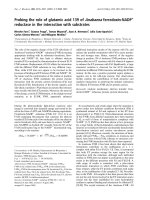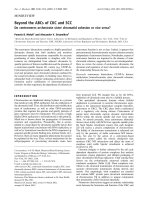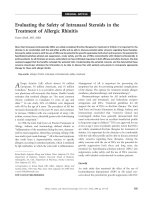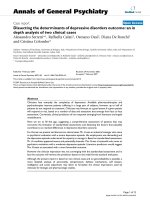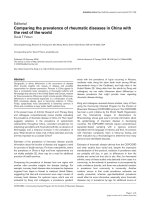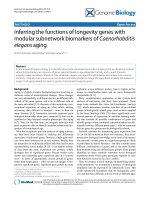Báo cáo y học: "Meeting the challenges of drug discovery: a multidisciplinary re-evaluation of current practices" pptx
Bạn đang xem bản rút gọn của tài liệu. Xem và tải ngay bản đầy đủ của tài liệu tại đây (54.11 KB, 3 trang )
Genome Biology 2005, 6:330
comment
reviews
reports
deposited research
interactions
information
refereed research
Meeting report
Meeting the challenges of drug discovery: a multidisciplinary
re-evaluation of current practices
Stephen K Burley and Frances Park
Address: SGX Pharmaceuticals Inc., 10505 Roselle Street, San Diego, CA 92121, USA.
Correspondence: Stephen K Burley. E-mail:
Published: 24 June 2005
Genome Biology 2005, 6:330 (doi:10.1186/gb-2005-6-7-330)
The electronic version of this article is the complete one and can be
found online at />© 2005 BioMed Central Ltd
A report on the Keystone Symposium ‘Meeting the
Challenges of Drug Discovery’, Vancouver, Canada, 15-19
January 2005.
With the cost of bringing a new therapeutic agent to the
market now estimated at around US$1.4 billion and the dis-
appointing pace of approvals of new therapeutics, the phar-
maceutical and biotechnology industries are under increasing
pressure to improve the efficiency and economics of drug dis-
covery and development. A Keystone Symposium in January
on the challenges of drug discovery brought together an
eclectic group of innovators. An ambitious meeting program
encompassed target validation, lead-identification strategies,
novel screening approaches, early detection of toxicity, more
predictive animal models, new biomarkers, molecular profil-
ing, and new biological agents.
Leslie Brown (Pharmacopeia, Princeton, USA) in his keynote
lecture gave an entertaining and wide-ranging analysis of the
myriad financial and technical challenges facing the phar-
maceutical and biotechnology industries. His message can
be summed up as: “use the right technology to find the right
drug modulating the right target in the right patient”. We
learned over the next four days that such advice is easy to
give but more difficult to heed.
Using the right technology
Several complementary strategies for speeding up the drug-
discovery process were presented. David Burns (Abbott Lab-
oratories, Abbott Park, USA) described how he and
colleagues are using high-throughput screening to accelerate
the initial discovery of biologically active molecules (lead
compounds) that may turn out to be potential drugs. He
stressed the importance of using complementary screens for
the effects of lead compounds on a target to increase the
yield of bona fide hits. For a protein kinase target, for
example, one would need enzyme assays of the kinase
domain plus assays for the full-length protein, combined with
screens of binding affinity, effects on the signaling pathway,
and whole-cell responses. Stewart Noble (Kalypsys, San
Diego, USA) also showed the power of high-throughput
screening for identifying compounds that modulate particu-
lar signal transduction pathways, presenting persuasive case
studies for signaling by the epidermal growth factor receptor
(EGFR), the neutrophil oxidative burst, and inducible nitric
oxid synthase (iNOS). One of us (S.B.) described FAST™, a
novel fragment-based strategy for identifying high-quality,
patentable, low molecular-weight lead compounds, with
binding constants in the nanomolar range, that inhibit forms
of the oncogenic protein kinase Bcr-Abl that are resistant to
inhibition by the anticancer drug Gleevec™.
Gerhard Klebe (Phillips University, Marburg, Germany) pro-
vided a glimpse of the future by illustrating the potential of
computerized ‘virtual’ ligand screening with a number of
compelling case studies. Most impressive were his team’s
efforts at targeting tRNA transglycosylase, with the goal of
developing an antibiotic against Shigella, a cause of dysen-
tery. In silico screening successfully identified inhibitors
with micromolar IC
50
values (the concentration of inhibitor
that inhibits 50% of the enzyme) that were then purchased,
tested in vitro, and structurally validated by X-ray crystallog-
raphy. Chand Khanna (National Cancer Institute, Bethesda,
USA) described the importance of using a clinical trials
approach with companion animals for early animal studies of
possible human anti-cancer agents. The use of companion
animals instead of laboratory dogs and rodents appears to be
more advantageous, because results obtained with such het-
erogenous animal populations have proven to be more rep-
resentative of human responses in subsequent clinical trials
than the more uniform laboratory populations. For example,
his studies of c-Kit inhibitors in canine mast-cell tumors
revealed consistently different pharmacokinetic and toxicity
profiles of the inhibitors in dogs bearing natural tumors
compared with laboratory beagle cancer models.
Selecting the right target
Large-scale examinations of the human genome were illus-
trated by three speakers, all intent on comprehensive target
validation. Brian Zambrowicz and colleagues (Lexicon
Genetics, The Woodlands, USA) are using mouse gene
knockouts to examine the estimated 5,000 druggable targets
in the mouse genome. Comprehensive evaluation of around
2,000 gene knockouts was reported to have spawned 60 new
drug-discovery programs.
This heroic effort was contrasted with applications of RNA
interference (RNAi) technology to produce gene knockouts
(Frank Koentgen, Ozgene, Australia) and gene knockdowns
(William Wishart, Novartis Institutes for Biomedical
Research, Cambridge, USA). Koentgen described how the use
of modified lentivirus vectors, which integrate into the
genome, has proved a fast and reliable method for producing
transgenic mice and rats. Related attempts to use lentiviral
vectors encoding interfering RNAs to produce ‘lenti-RNAi’
and ‘inducible lenti-RNAi’ knockdown mice have also shown
early promise using tyrosinase as the target gene. Wishart
presented a genome-wide approach to target identification
for the relief of chronic pain by using expression profiling
with a P2X3 pain receptor case study. Murray Robinson
(GenPath Pharmaceuticals, which is now known as AVEO
Pharmaceuticals, Cambridge, USA) explained how experi-
mentally inducible tumors can be used for both target identi-
fication and drug discovery. In such tumor models,
insertional mutagenesis screens have identified new genes
complementary to known oncogenes.
Avoiding the wrong drugs
Early detection of toxicity is critical to ensuring that only suit-
able drugs are put into clinical trials. Dale Johnson (Chiron
Corporation, Emeryville, USA) presented computational
approaches to the prediction of drug-induced toxicity. Kyle
Kolaja (Iconix Pharmaceuticals, Mountain View, USA)
explained the potential of the company’s DrugMatrix, a pro-
prietary chemogenomics database that incorporates informa-
tion from animal studies, gene-expression profiling, in vitro
assays and literature sources. The power of the method was
illustrated by the identification and use of kidney biomarkers
as early predictors of nephrotoxicity.
Stephen Durham (Bristol-Myers Squibb, Princeton, USA)
and James McKim (CeeTox, Kalamazoo, USA) both
described the benefits of early application of in vitro toxicol-
ogy studies to identifying potential liabilities before substan-
tial resources are devoted in animal and human testing. Par-
ticularly impressive was McKim’s use of in vitro cell-based
toxicity screens early in the drug discovery process to predict
toxicity in vivo. Roger Ulrich (Rosetta Inpharmatics, Seattle,
USA) is applying microarray technology to toxicogenomics
with the goal of reducing adverse drug reactions. After
describing the power of the technique in general terms, he
presented an informative case study on determining the tox-
icity of potential inhibitors to the chemokine receptor CCR5,
a receptor used by the human immunodeficiency virus (HIV)
to enter cells.
Making the right clinical decisions
There remains the challenge of matching the “right drug to
the right patient”. Good clinical decision-making rarely
follows a straightforward path, but there are grounds for
optimism. Todd Golub (Dana Farber Cancer Institute,
Boston, USA) described gene-expression profiling of various
human cancers combined with gene-set enrichment analyses
to detect signatures of disease. In addition, he suggested that
miRNA signatures could be used to evaluate the potential
utility of particular compounds in treating cancer.
Samir Hanash (Fred Hutchinson Cancer Center, Seattle,
USA) and colleagues are applying a host of proteomic tools
to samples from human patients with the aim of establishing
tissue- and serum-based markers for both diagnostics and
functional classification of disease. He described the capture
of cell-surface proteins via biotinylation to examine differ-
ences in expression levels and expression patterns between
malignant and normal cells. Finally, Irene Tracey (Oxford
University, UK) showed how functional magnetic resonance
imaging (MRI) of pain processing in humans is being used to
relate directly the effects of analgesic agents on neurophysio-
logic markers to patient perceptions of efficacy.
New types of therapeutics
Over the past two decades a number of alternative platforms
for drug discovery have allowed the industry to go well
beyond small-molecule and oligopeptide drugs. Recombi-
nant proteins, monoclonal antibodies, gene therapy, anti-
sense, RNAi, and aptamers each represent relatively
unexplored frontiers for drug discovery. Antibodies, anti-
sense and RNAi were the focus of a session entitled ‘Biolog-
ics’, which does not do justice to the enormous potential of
these novel modalities.
Napoleone Ferrara (Genentech, San Francisco, USA)
recounted the odyssey-like discovery and development of
Avastin, a non-immunogenic recombinant humanized
monoclonal antibody (93% human, 7% mouse) that targets
vascular endothelial growth factor (VEGF) and is now used
as first-line treatment for metastatic colorectal carcinoma.
Frank Bennett (ISIS Pharmaceuticals, Carlsbad, USA)
330.2 Genome Biology 2005, Volume 6, Issue 7, Article 330 Burley and Park />Genome Biology 2005, 6:330
summarized the relative predictability of antisense oligo-
nucleotides as therapeutic agents and their potential to
improve efficacy and lower costs. For the uninitiated, not to
mention those skeptics who recall the checkered past of anti-
sense approaches, he explained the multiple mechanisms by
which oligonucleotides act on RNA and described how
medicinal chemistry has improved their potency and phar-
macokinetic properties, and lowered their cost.
Finally, John Maraganore (Alnylam Pharmaceuticals, Cam-
bridge, USA) discussed therapeutic applications of RNAi, as
exemplified by an siRNA-based agent against respiratory
syncytial virus (RSV) agent, which has good cell permeability
and appropriate albumin binding, plasma half-life, and
tissue distribution. The painstaking development process
involves choosing the right sequence, modifying the oligonu-
cleotide backbone to avoid nuclease digestion, and then con-
jugating it with cholesterol to improve both plasma half-life
and biodistribution. The message from these three talks was
clear. Biologics can offer superior validation, better
pharmacokinetic properties, and more predictable toxicity
profiles, which often mean a faster path to successful proof-
of-concept clinical trials.
During this meeting, we learned a great deal about how
different organizations are working to implement facets of
Leslie Brown’s prescription to “use the right technology to
find the right drug modulating the right target in the right
patient”. It was made clear that genomic approaches to the
problem are likely to bear considerable fruit over the next
five years. Integration of diagnostic tools with predictive
pharmacology and toxicology should prove particularly ben-
eficial as academic and industrial efforts drive towards more
individualized clinical trials and, ultimately, more individu-
alized medical care. The prospects for both drug-discovery
and drug-development scientists and their patients look
better and better. Precisely how the pharmaceutical industry
is going to position itself to deal with the changing econom-
ics of personalized medicine would make an interesting
addition to the program when this same group meets again
in a few years.
comment
reviews
reports
deposited research
interactions
information
refereed research
Genome Biology 2005, Volume 6, Issue 7, Article 330 Burley and Park 330.3
Genome Biology 2005, 6:330


